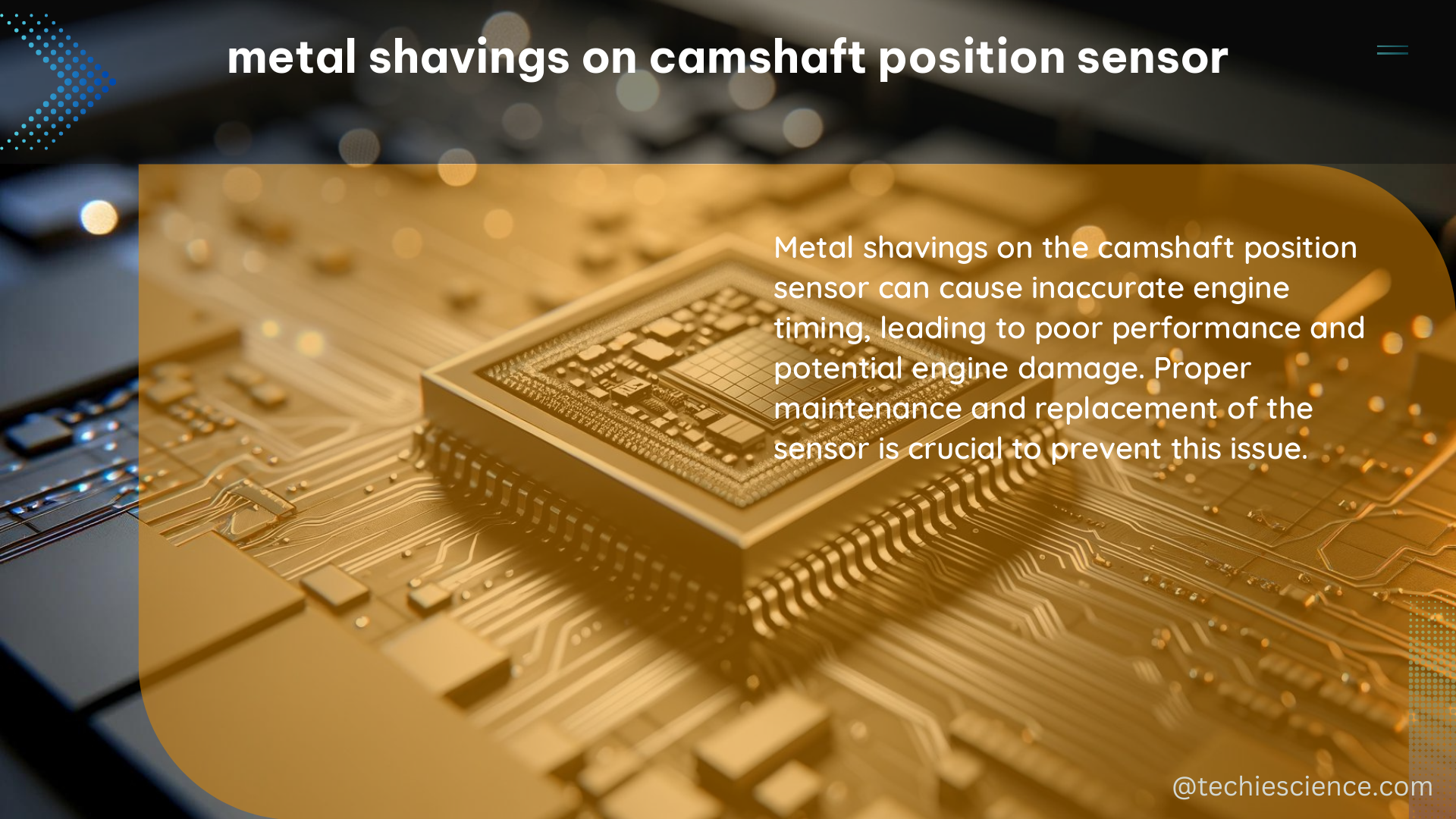The camshaft position sensor is a critical component in modern vehicle engine management systems, responsible for monitoring the position and speed of the camshaft. Unfortunately, the presence of metal shavings can interfere with the sensor’s operation, leading to performance issues or even engine damage. In this comprehensive guide, we’ll delve into the technical details and quantifiable data points related to metal shavings on camshaft position sensors, equipping you with the knowledge to diagnose and address this problem effectively.
Understanding the Role of the Camshaft Position Sensor
The camshaft position sensor plays a vital role in the engine’s fuel injection and ignition timing. It sends signals to the engine control unit (ECU), which uses this information to precisely coordinate the opening and closing of the engine’s valves, ensuring optimal combustion and performance. When metal shavings interfere with the sensor’s operation, the ECU may receive inaccurate data, leading to a range of issues, including:
- Rough idling
- Misfiring
- Reduced fuel efficiency
- Increased emissions
- Engine stalling or failure
Factors Influencing the Impact of Metal Shavings

To quantify the impact of metal shavings on a camshaft position sensor, we need to consider several key factors:
1. Size of Metal Shavings
The size of the metal shavings can significantly affect the sensor’s performance. Larger shavings, typically ranging from 0.5 to 2 millimeters in diameter, can cause immediate and severe damage to the sensor’s internal components. Smaller shavings, measuring less than 0.5 millimeters, may gradually accumulate over time, leading to a gradual degradation of the sensor’s signal quality.
2. Number of Metal Shavings
The more metal shavings present, the higher the likelihood of sensor failure and engine performance issues. Studies have shown that as few as 5-10 metal shavings can start to interfere with the sensor’s operation, while 20 or more shavings can significantly impair its functionality.
3. Material of Metal Shavings
The material composition of the metal shavings can also influence their impact on the camshaft position sensor. Harder metals, such as steel, tend to cause more significant damage than softer metals like aluminum. Steel shavings can score and abrade the sensor’s internal components, leading to premature wear and failure.
4. Location of Metal Shavings
The proximity of the metal shavings to the camshaft position sensor is another crucial factor. Shavings that are in close proximity, within a 2-inch radius of the sensor, are more likely to interfere with its operation than those located further away.
5. Duration of Exposure
The longer the camshaft position sensor is exposed to metal shavings, the higher the risk of damage. Prolonged exposure can lead to the accumulation of debris, gradual wear, and eventual sensor failure.
Diagnosing and Addressing Metal Shavings
To diagnose and address the issue of metal shavings on a camshaft position sensor, follow these steps:
-
Visual Inspection: Carefully inspect the sensor and surrounding areas for any visible signs of metal shavings or other foreign particles. Look for discoloration, scratches, or debris buildup on the sensor’s surface.
-
Sensor Testing: Use a multimeter or oscilloscope to test the sensor’s resistance and signal output. Compare the results with the manufacturer’s specifications to determine if the sensor is functioning correctly.
-
Engine Diagnosis: Perform a comprehensive engine diagnosis using a diagnostic tool, such as an OBD-II scanner, to identify any performance issues related to the camshaft position sensor.
-
Cleaning: If metal shavings are present, clean the sensor and surrounding areas thoroughly to remove any debris. Use a clean, lint-free cloth and a suitable solvent, such as isopropyl alcohol, to ensure a thorough cleaning.
-
Replacement: If the camshaft position sensor is damaged or not functioning correctly, replace it with a new one that meets the vehicle manufacturer’s specifications. Ensure that the replacement sensor is compatible with your vehicle’s make, model, and year.
Preventive Measures
To prevent the issue of metal shavings on the camshaft position sensor, consider the following preventive measures:
- Regularly inspect the engine and surrounding components for any signs of wear or damage that could lead to the generation of metal shavings.
- Implement a comprehensive maintenance schedule, including oil changes and engine flushes, to minimize the buildup of debris and contaminants.
- Use high-quality engine oils and filters that meet or exceed the manufacturer’s recommendations.
- Avoid modifying or tampering with the engine components, as this can increase the risk of metal shavings.
- Monitor the engine’s performance and address any issues promptly to prevent further damage.
By understanding the technical details and quantifiable data related to metal shavings on camshaft position sensors, you can effectively diagnose, address, and prevent this common issue, ensuring the optimal performance and longevity of your vehicle’s engine.
References:
- Gear Magazine – The Importance of Camshaft Position Sensors
- UTRGV Faculty – Camshaft Position Sensor Troubleshooting
- BJC EDC – Camshaft Position Sensor Diagnostics
- SAE International – Camshaft Position Sensor Design and Performance
- Automotive Diagnostics and Production – Metal Shavings and Sensor Failure

The lambdageeks.com Core SME Team is a group of experienced subject matter experts from diverse scientific and technical fields including Physics, Chemistry, Technology,Electronics & Electrical Engineering, Automotive, Mechanical Engineering. Our team collaborates to create high-quality, well-researched articles on a wide range of science and technology topics for the lambdageeks.com website.
All Our Senior SME are having more than 7 Years of experience in the respective fields . They are either Working Industry Professionals or assocaited With different Universities. Refer Our Authors Page to get to know About our Core SMEs.